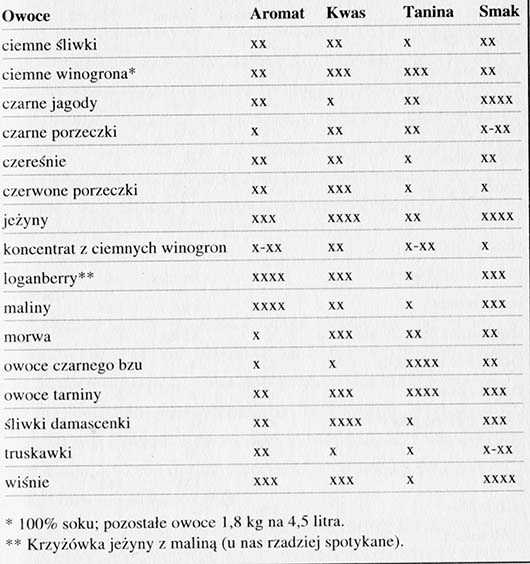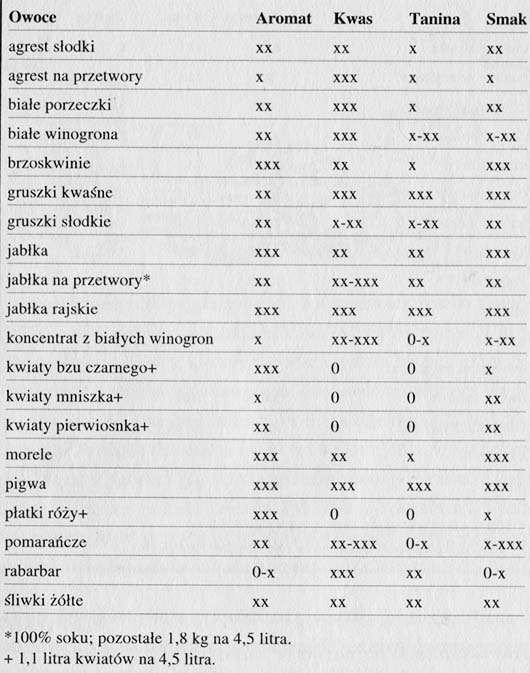 For the fermentation to run as smoothly as possible, you need to keep the right proportions of ingredients. The only fruits, which allow you to keep the ideal proportions of sugar, acid, aroma, tanin, water and yeast, there are grapes. Because we're going to use different fruits, we have to take care, that the proportions of our ingredients are close to the ideal, if we want good quality wine. To get the desired result, it is common to mix different kinds of fruit or add grape concentrate, but in this case, I would recommend caution. Concentrate also affects the nobler taste of wine.
For the fermentation to run as smoothly as possible, you need to keep the right proportions of ingredients. The only fruits, which allow you to keep the ideal proportions of sugar, acid, aroma, tanin, water and yeast, there are grapes. Because we're going to use different fruits, we have to take care, that the proportions of our ingredients are close to the ideal, if we want good quality wine. To get the desired result, it is common to mix different kinds of fruit or add grape concentrate, but in this case, I would recommend caution. Concentrate also affects the nobler taste of wine.
TABLE 1. PRODUCTS FOR CLASSIC RED WINE
The table below shows the aromatic and taste qualities as well as the acid and tannin content of the most popular fruits compared to dark grapes.

Acidity
Most of the available fruits or other wine ingredients have low acidity, so you need to add some acid to them. It can be lemon juice, grape acid or citric acid powder. In my opinion, the latter is the best, because its quantity can be measured precisely. If the recipe requires the addition of lemon juice, it is hardly known, what does it mean.
With small or large lemon; with more or less juicy; from acidic or less acidic? We do not know, how much acid did we actually add, and even if we manage to achieve perfect proportions, then there are little chances, that we can repeat the same result.
Citric acid is most often used in the production of wines (found in lemons), but not only. We can also use tartaric acid, which is found in grapes, or apple – in apples and other stone fruits. All of these products are available in powdered form and can be mixed. In my opinion, we will achieve the best result, combining them in the following ratio: 50% tartaric acid, 30% apple and 20% lemon (we must also take into account the acid content of the fruit, which we will use). We need to know what kind of acid are contained in different types of fruit and other products (Note, that in the case of fruits containing more than one acid, the given values of the individual substances are indicative of this fruit only. So if a specific fruit contains 10 parts of the acid, does not mean it, that it is sour than this, which contains less of it. For example, strawberries are not too acidic, but the ratio of citric acid to malic acid is in them 9:1).
Table 2. products for classic white wine
The table below shows the aromatic and taste qualities as well as the acid and tannin content of the most popular fruits compared to white grapes.
Tanina
Dodanie land (garbnika) it may be necessary, if the products we use have a bland taste (Look: table 1 i 2). It is a substance, which gives the wine its character – without it, the drink would not have the depth of its flavor, i.e.. would be bland. Most red wines contain a sufficient amount of tannin, but for some whites you need to add a little tannin solution (a small teaspoon on 4,5 a liter or a few drops).
Tannin in addition to reviving the taste of wine, it is also suitable for its clarification. In some types of wine, for example, from elderberry fruits, tannin content may initially be too high, but over time its power weakens, because most tart young wines only after a longer ripening acquire the appropriate nobility.
Yeast
Today, there are many varieties of yeast available, which greatly facilitates the production of homemade wines. To begin with, universal yeast is enough, but planning to produce a specific type of wine, nobler yeast cultures should be used. If we choose the right ingredients, we can get a wine of good quality, similar in taste to quality wines. Special varieties of yeast can be purchased in liquid or powdered form; we will make leaven from them, which will prevent the delay in fermentation and the growth of bacteria.
Let us not be fooled by opinions, that you can make wine without yeast. It's impossible – without yeast, fermentation simply will not take place. If anyone claims, that he produces wine without the addition of yeast, it just means, that on the peel of the fruit, from which it produces them, there are wild strains of these microorganisms causing fermentation. The wine obtained in this way has a low alcohol content and is tasteless. That's why I advise, to wash all fruit thoroughly before use and to use noble yeast varieties.
Sugar
We have already touched on the question of sugar initially. However, I have to remind you, that you should never add too much sugar to the must. Then – during fermentation – we can sprinkle sugar, if it is necessary, but an excess of it inhibits the work of the yeast, and as a result, we always get sweet wine. I advise you to add sugar in batches - even if you want to get sweet, dessert wine. It makes, yeast works better, and the final product contains more alcohol.
Another problem is how the sugar is added. We can of course pour everything in at once, but there is a concern, that the sugar will not completely dissolve. Therefore, it is better to make a syrup, which we will pour gradually, depending on the needs.
Here is a simple syrup recipe:
Ingredients:
900 g of sugar
1/2 liter of cold water
1/2 teaspoons of citric acid
How to prepare
Pour sugar into a saucepan and add half of the water and citric acid. Bring to a boil and cook 20-25 minutes on a slow fire, stirring frequently, until the syrup acquires a golden color. We turn off the gas, add the rest of the water and mix thoroughly. Leave to cool.
Water and fruit
These two components are closely related, so I'll discuss them together. Proportions of water and fruit (or other flavoring ingredients) depend on the latter. In England, the assumption was adopted, that the amount of water should be equal to the strength of the wine, but due to the use of a different measurement system, it does not apply to Polish conditions (because wine usually has 8% Alcohol, most often it is used for its production 8 half a quart of water – that is 4,5 Litre). Remember, that fermentation juice and the grape concentrate solution should be obtained from the part of the water intended for wine production (that is these 4,5 Litre), and not with extra water. Otherwise the wine will be very weak.
The strength of the wine depends to some extent on the fermentation time of the must (that is, from this, how long does the fermentation of the liquid combined with the solid ingredients take - without decanting the wine). However, there is a risk, that the long aerobic fermentation will bring out the maximum flavor from the fruit, but it will also change the taste and appearance of the wine due to the precipitation of amino acids from the dead yeast. Therefore, the fermentation of the must should not take longer than 5 Days. In practice, most experienced manufacturers keep fermentation through 3 Days (if he wants table wine), and then purses and draws the must and sets only the juice. This really means faster fermentation and less tannin content in the case of red wine; may result in a loss of flavor, if we don't use more fruit.
Vitamin B1 and magnesium sulfate
Some recipes have these two minor ingredients. Their presence may surprise beginners a bit. Vitamin B1 tablets are not essential, but they help the yeast in the fermentation process. In turn, magnesium sulfate is added to too soft water. In the vicinity, where there is hard water, this component can be omitted.